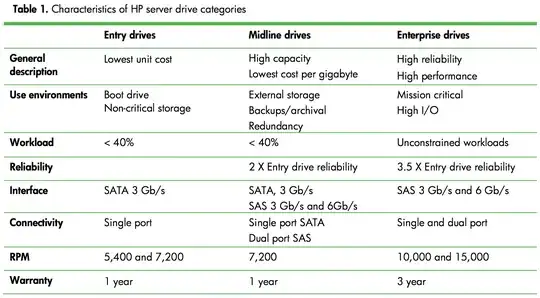What is the rule of thumb in performance characteristics and differences between 7200rpm (SATA/SAS) and 15000rpm (SAS) hard disc drives of the same generation?
-
1Why this question downvoted? – cnst May 31 '13 at 21:26
-
Lots of information out there. 7.2k and 10k/15k disks are vastly different in capacity and performance. SAS versus SATA as well. You didn't give a specific example of workload requirements or a situation where a more concrete recommendation could apply. – ewwhite Jun 09 '13 at 08:40
-
heh, so funny -- 10k views, yet +3/-2 = 1 net vote! – cnst Dec 25 '14 at 04:04
3 Answers
It's a case of math. I/O-per-second is determined by the following calculation:
Random I/O = 1000/ (average latency + seek time)
For a 7.2K RPM drive, a seek-time of 8.5ms and latency of 4.16 gives an IOPS number of 78.
For a 15K RPM drive, a seek-time of 2.6ms and latency of 2.0ms gives an IOPS number of 217 .
For a 15K RPM drive, a seek-time of 3.4ms and latency of 2.0ms gives an IOPS number of 185.
These are just examples based on a selection of current (as of this writing) drives from Seagate.
Interface (SAS vs SATA) doesn't impact these numbers meaningfully. The RPMs are what determine the performance. Sequential I/O performance is a different number, but most server I/O these days is significantly random.
As you can see, the performance difference between the two tiers of speed can be quite significant.
- 131,083
- 18
- 173
- 296
-
-
-
@cnst It does, but it depends a lot on the drive itself. The 7.5K I used above maxes out at 115MB/s, where the second 15K is listed as a range from 122-204 MB/s. Random I/O is where the big differences are. – sysadmin1138 May 31 '13 at 19:43
-
@sysadmin1138, i'm specifically talking about drives of the same generation, are your drives of the same generation? – cnst May 31 '13 at 19:53
-
@cnst Yes, all three are currently shipping. The two 15K's are different product lines from the same manufacturer, just aimed at slightly different markets. – sysadmin1138 May 31 '13 at 19:57
-
1We usually use 180 IOPS as a rule of thumb for a 15k disk, just remember that if you are using RAID you have to divide that (raid 10 is 180 read IOPs, 90 write IOPS, or 1:2... raid 5 is 1:4, raid 6 is 1:8 if I remember correctly). – Matthew May 31 '13 at 20:21
-
btw, if you don't mind, could you also give 5.4k figures for full comparison? it seems like hetzner.de servers all have those stupid 5.4k discs (my server (from bidding) with quad-core extreme cpu still originally came with just 3x 5.4k 1.5TB WD drives), so i think it'll be useful for people to compare against, too. – cnst Jun 01 '13 at 17:58
-
1@cnst Seems manufacturers won't publish seek/access figures on 5.4k drives. It seems the WD Red drive (4TB 3.5" 5.4k) tests at 16.38 ms read and 7.36 ms write latency (which somehow includes 5.52 ms rotational latency). By the formula, this will produce 61 read IOPS and 136 write IOPS. If you want to know specs for a particular drive, you should expect it to be benchmarked somewhere, and look it up. With a queue depth of 32, the drive can pull >140 IOPS in a mixed read/write pattern. – jbo5112 Nov 16 '16 at 00:07
-
@jbo5112, IBM/HGST is traditionally the only company that published all specs for all of their HDD products – cnst Nov 16 '16 at 00:29
In short, they have different characteristics and purposes...
7200rpm disks are bigger and slower. 10000rpm and 15000rpm disks are smaller and faster. The latter are meant for high transactional and high random I/O workloads. The former are better for sequential transfer and high capacity requirements.
From HP's documentation:
HP Entry (SATA 7.2k) drives have the lowest unit cost and give you a basic level of reliability and performance. They are best suited for non-mission-critical environments where I/O workloads are 40 percent or less. They are typically best suited for internal/archival storage or as boot drives for entry-level servers.
HP Midline (SAS 7.2k) drives give you larger capacity and greater reliability than Entry drives. Midline drives are more resistant to rotational and operational vibration, so they are better suited for use in multi-drive configurations. HP Midline drives are for high-capacity applications such as external storage that may require increased reliability. Like Entry drives, however, Midline drives are for use in moderate workload environments. We do not recommend Entry or Midline drives for mission-critical applications.
HP Enterprise (SAS 10k/15k) drives give you maximum reliability, highest performance, scalability, and error management under the most demanding conditions. They are the only HP drives designed for use at unconstrained I/O workloads. They are for mission-critical applications such as large databases, e-mail servers, and back-office.

- 194,921
- 91
- 434
- 799
From a value point of view, one can often get better real world performance out of more SATA 7.2k drives than fewer SAS 15k drives with the price being similar. You'll notice that larger buildouts like Backblaze use SATA and that's because the value is so much better and if you use multiple SATA drives, the performance can match for typical storage loads.
- 1,557
- 3
- 13
- 12